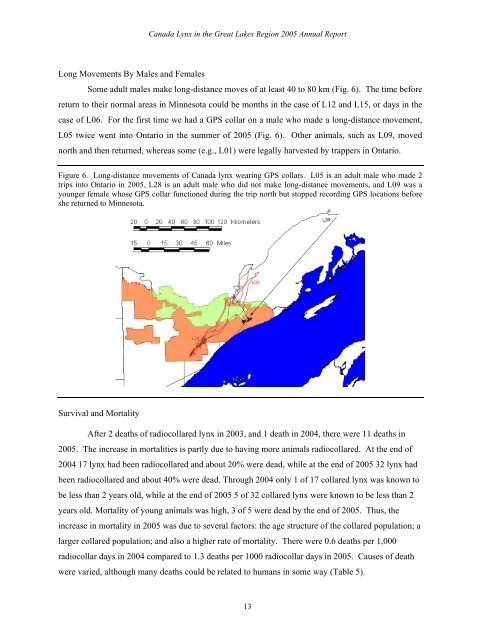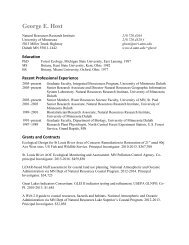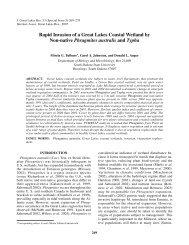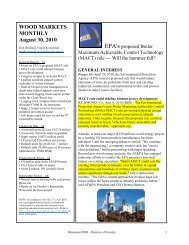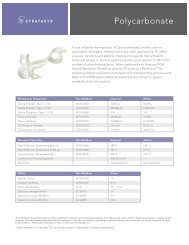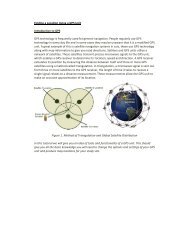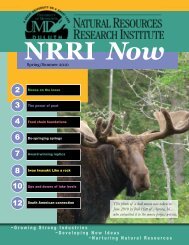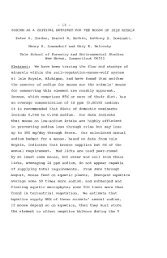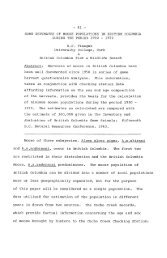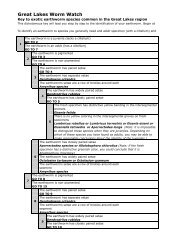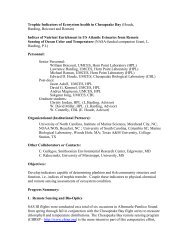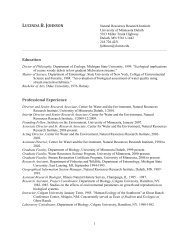Canada Lynx in the Great Lakes Region - Minnesota Department of ...
Canada Lynx in the Great Lakes Region - Minnesota Department of ...
Canada Lynx in the Great Lakes Region - Minnesota Department of ...
You also want an ePaper? Increase the reach of your titles
YUMPU automatically turns print PDFs into web optimized ePapers that Google loves.
<strong>Canada</strong> <strong>Lynx</strong> <strong>in</strong> <strong>the</strong> <strong>Great</strong> <strong>Lakes</strong> <strong>Region</strong> 2005 Annual ReportLong Movements By Males and FemalesSome adult males make long-distance moves <strong>of</strong> at least 40 to 80 km (Fig. 6). The time beforereturn to <strong>the</strong>ir normal areas <strong>in</strong> M<strong>in</strong>nesota could be months <strong>in</strong> <strong>the</strong> case <strong>of</strong> L12 and L15, or days <strong>in</strong> <strong>the</strong>case <strong>of</strong> L06. For <strong>the</strong> first time we had a GPS collar on a male who made a long-distance movement,L05 twice went <strong>in</strong>to Ontario <strong>in</strong> <strong>the</strong> summer <strong>of</strong> 2005 (Fig. 6). O<strong>the</strong>r animals, such as L09, movednorth and <strong>the</strong>n returned, whereas some (e.g., L01) were legally harvested by trappers <strong>in</strong> Ontario.Figure 6. Long-distance movements <strong>of</strong> <strong>Canada</strong> lynx wear<strong>in</strong>g GPS collars. L05 is an adult male who made 2trips <strong>in</strong>to Ontario <strong>in</strong> 2005, L28 is an adult male who did not make long-distance movements, and L09 was ayounger female whose GPS collar functioned dur<strong>in</strong>g <strong>the</strong> trip north but stopped record<strong>in</strong>g GPS locations beforeshe returned to M<strong>in</strong>nesota.Survival and MortalityAfter 2 deaths <strong>of</strong> radiocollared lynx <strong>in</strong> 2003, and 1 death <strong>in</strong> 2004, <strong>the</strong>re were 11 deaths <strong>in</strong>2005. The <strong>in</strong>crease <strong>in</strong> mortalities is partly due to hav<strong>in</strong>g more animals radiocollared. At <strong>the</strong> end <strong>of</strong>2004 17 lynx had been radiocollared and about 20% were dead, while at <strong>the</strong> end <strong>of</strong> 2005 32 lynx hadbeen radiocollared and about 40% were dead. Through 2004 only 1 <strong>of</strong> 17 collared lynx was known tobe less than 2 years old, while at <strong>the</strong> end <strong>of</strong> 2005 5 <strong>of</strong> 32 collared lynx were known to be less than 2years old. Mortality <strong>of</strong> young animals was high, 3 <strong>of</strong> 5 were dead by <strong>the</strong> end <strong>of</strong> 2005. Thus, <strong>the</strong><strong>in</strong>crease <strong>in</strong> mortality <strong>in</strong> 2005 was due to several factors: <strong>the</strong> age structure <strong>of</strong> <strong>the</strong> collared population; alarger collared population; and also a higher rate <strong>of</strong> mortality. There were 0.6 deaths per 1,000radiocollar days <strong>in</strong> 2004 compared to 1.3 deaths per 1000 radiocollar days <strong>in</strong> 2005. Causes <strong>of</strong> deathwere varied, although many deaths could be related to humans <strong>in</strong> some way (Table 5).13


